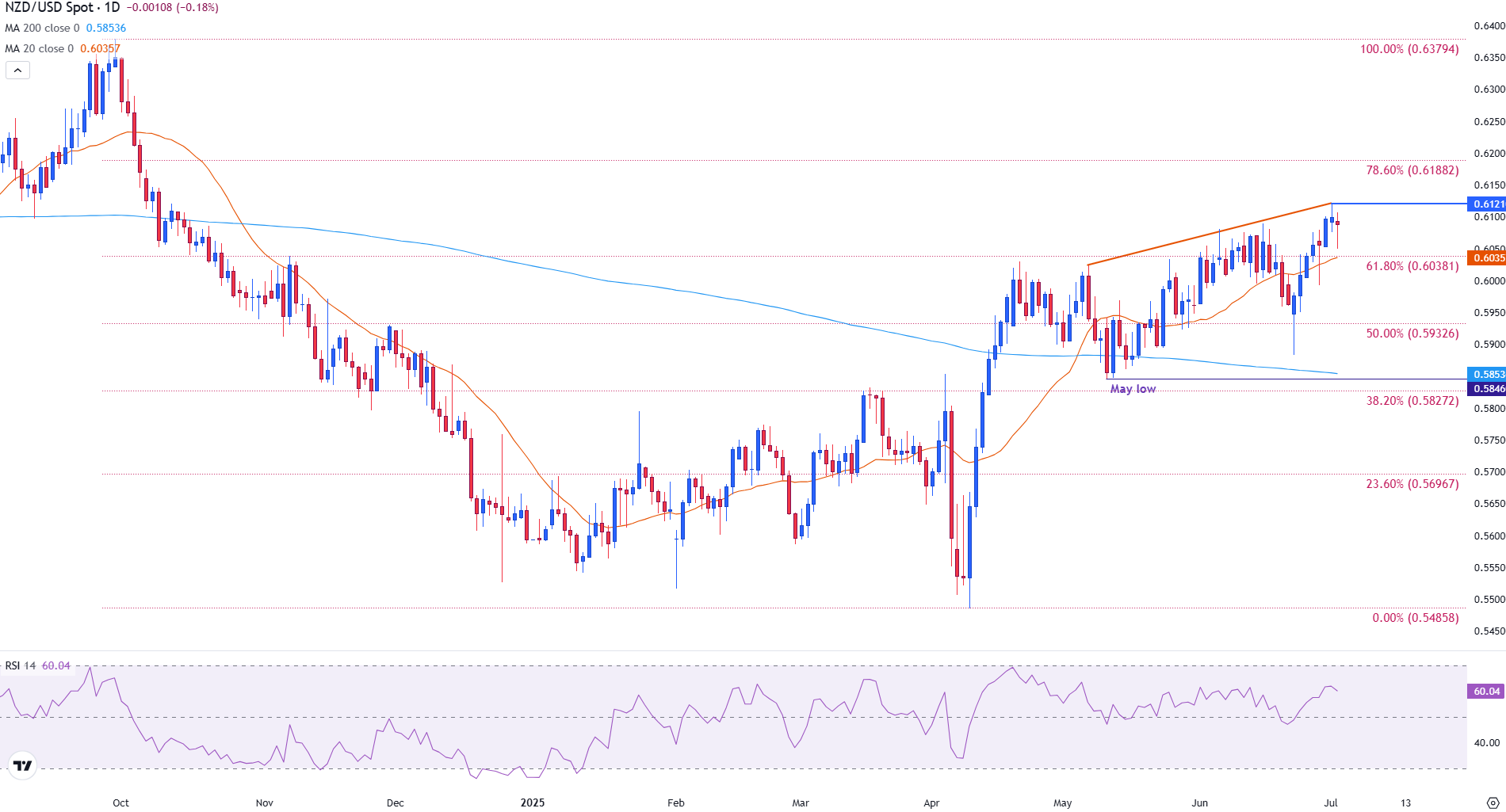
- NZD/USD retreats from eight-month highs of 0.6121.
- The US Nonfarm Payrolls report will be released on Thursday, with forecasts indicating that 110,000 new jobs were added in June.
- The Kiwi remains vulnerable to changes in interest rate expectations and risk sentiment.
The New Zealand Dollar (NZD) is trading lower against the US Dollar (USD) on Wednesday as markets look ahead to Thursday’s US Nonfarm Payrolls (NFP) report.
The NFP data is expected to show that 110K new jobs were added in June, down from 139K in the previous month. The report is highly anticipated, especially after Wednesday’s ADP Employment Change report, which came in well below expectations with a net loss of 33K jobs.
While the Federal Reserve (Fed) has remained committed to keeping interest rates at higher levels while it monitors the evolution of inflation, the Reserve Bank of New Zealand (RBNZ) has raised concerns about weakening economic conditions.
To stimulate the economy, the RBNZ has reduced interest rates, with the latest cut driving the benchmark rate to 3.25% in June.
Meanwhile, the Fed has kept interest rates within the 4.25% to 4.50% range.
However, after Wednesday’s Automatic Data Processing (ADP) report revealed that the employment situation in the US private sector continues to deteriorate. The June report revealed a 33,000 decline, missing analyst expectations for a 95,000 increase by a large margin.
So far, Fed Chair Jerome Powell has adhered to the cautious script, but investors are aware that this could shift quickly if the data dictates otherwise.
Speaking at the European Central Bank (ECB) forum on Tuesday, Powell stated that “It’s going to depend on the data, and we are going meeting by meeting. I wouldn’t take any meeting off the table or put it directly on the table. It’s going to depend on how the data evolves.”
These comments suggest that the outcome of the June Nonfarm Payrolls could set the tone for the upcoming Fed interest rate decision.
NZD/USD edges lower after reaching a fresh YTD high near 0.6121 on Tuesday
At the time of writing, the NZD/USD pair is trading below the psychological resistance level of 0.6100, with Tuesday’s high providing additional resistance at 0.6121.
The inability of bulls to gain traction above 0.6100 indicates that they may be running out of steam.
This narrative is further reinforced by the Relative Strength Index (RSI), which is approaching the 60 mark. While a reading above 50 indicates a bullish sentiment, the RSI is pointing lower, suggesting that buying pressure is easing.
NZD/USD daily chart

If NZD/USD holds above the 20-day Simple Moving Average (SMA) support level of 0.6035 and rebounds toward 0.6121, a breakout above this recent high could pave the way for the 78.6% Fibo level of the September-April decline near 0.6188.
In contrast, a move below the 61.8% retracement at 0.6038 and a break of the 0.6000 level may open the door for a deeper retracement toward the 50% Fibo level around 0.5933.
New Zealand Dollar FAQs
The New Zealand Dollar (NZD), also known as the Kiwi, is a well-known traded currency among investors. Its value is broadly determined by the health of the New Zealand economy and the country’s central bank policy. Still, there are some unique particularities that also can make NZD move. The performance of the Chinese economy tends to move the Kiwi because China is New Zealand’s biggest trading partner. Bad news for the Chinese economy likely means less New Zealand exports to the country, hitting the economy and thus its currency. Another factor moving NZD is dairy prices as the dairy industry is New Zealand’s main export. High dairy prices boost export income, contributing positively to the economy and thus to the NZD.
The Reserve Bank of New Zealand (RBNZ) aims to achieve and maintain an inflation rate between 1% and 3% over the medium term, with a focus to keep it near the 2% mid-point. To this end, the bank sets an appropriate level of interest rates. When inflation is too high, the RBNZ will increase interest rates to cool the economy, but the move will also make bond yields higher, increasing investors’ appeal to invest in the country and thus boosting NZD. On the contrary, lower interest rates tend to weaken NZD. The so-called rate differential, or how rates in New Zealand are or are expected to be compared to the ones set by the US Federal Reserve, can also play a key role in moving the NZD/USD pair.
Macroeconomic data releases in New Zealand are key to assess the state of the economy and can impact the New Zealand Dollar’s (NZD) valuation. A strong economy, based on high economic growth, low unemployment and high confidence is good for NZD. High economic growth attracts foreign investment and may encourage the Reserve Bank of New Zealand to increase interest rates, if this economic strength comes together with elevated inflation. Conversely, if economic data is weak, NZD is likely to depreciate.
The New Zealand Dollar (NZD) tends to strengthen during risk-on periods, or when investors perceive that broader market risks are low and are optimistic about growth. This tends to lead to a more favorable outlook for commodities and so-called ‘commodity currencies’ such as the Kiwi. Conversely, NZD tends to weaken at times of market turbulence or economic uncertainty as investors tend to sell higher-risk assets and flee to the more-stable safe havens.
Information on these pages contains forward-looking statements that involve risks and uncertainties. Markets and instruments profiled on this page are for informational purposes only and should not in any way come across as a recommendation to buy or sell in these assets. You should do your own thorough research before making any investment decisions. FXStreet does not in any way guarantee that this information is free from mistakes, errors, or material misstatements. It also does not guarantee that this information is of a timely nature. Investing in Open Markets involves a great deal of risk, including the loss of all or a portion of your investment, as well as emotional distress. All risks, losses and costs associated with investing, including total loss of principal, are your responsibility. The views and opinions expressed in this article are those of the authors and do not necessarily reflect the official policy or position of FXStreet nor its advertisers. The author will not be held responsible for information that is found at the end of links posted on this page.
If not otherwise explicitly mentioned in the body of the article, at the time of writing, the author has no position in any stock mentioned in this article and no business relationship with any company mentioned. The author has not received compensation for writing this article, other than from FXStreet.
FXStreet and the author do not provide personalized recommendations. The author makes no representations as to the accuracy, completeness, or suitability of this information. FXStreet and the author will not be liable for any errors, omissions or any losses, injuries or damages arising from this information and its display or use. Errors and omissions excepted.
The author and FXStreet are not registered investment advisors and nothing in this article is intended to be investment advice.








